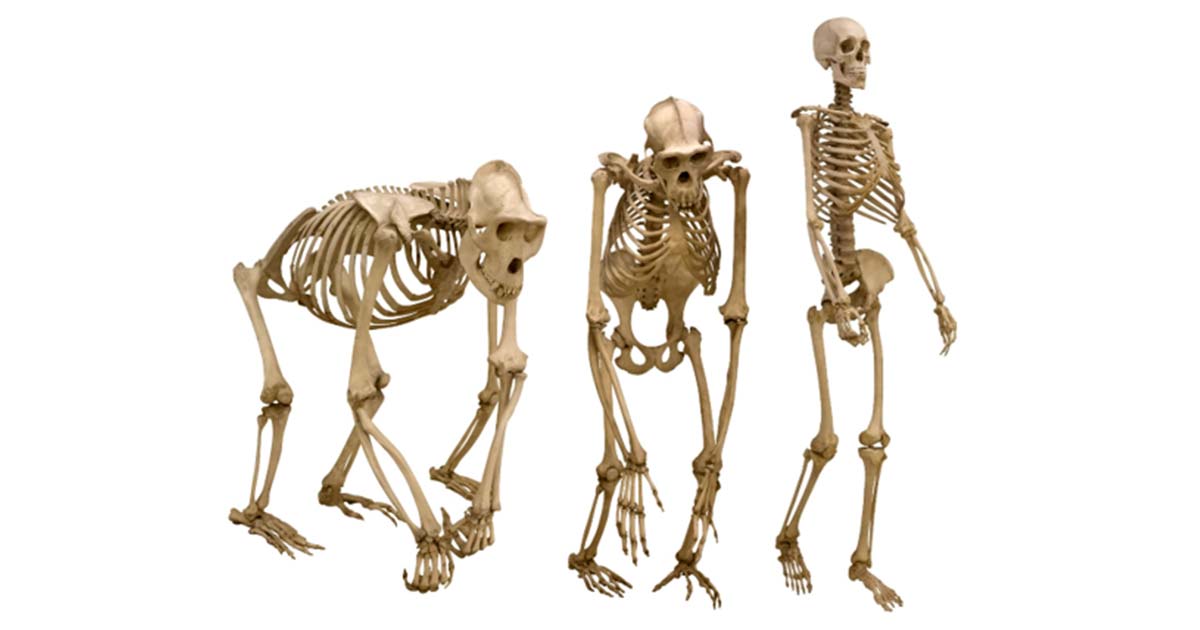New Study Sheds Light on Genetic Human Skeletal Changes that Led to Bipedalism
Researchers have conducted a groundbreaking study using imaging data from over 30,000 participants in the UK Biobank to gain insights into the genetic basis of human skeletal proportions and their evolutionary significance. The study's findings reveal how various skeletal changes on the path to modern humans have contributed to bipedalism, as well as increased susceptibility to musculoskeletal diseases.
Fathoming Skeletal Change
Humans are the only great apes that walk upright, a characteristic known as bipedalism. The distinctive skeletal form of modern humans, particularly changes in limb proportions, has long been a subject of interest in paleoanthropology. While previous studies have explored skeletal development and morphology mainly through animal models and comparative genomics, this new approach examines the genetic basis of skeletal traits directly in humans, utilizing a large dataset of full-body dual-energy x-ray absorptiometry (DXA) images from the UK Biobank.
- Outrage as India Deletes Darwinian Evolution from Textbooks
- Digital Scientists Resurrect A 30,000-Year-Old Egyptian Man
Genetic Influence on Skeletal Proportions
The research demonstrates that all skeletal proportions are highly heritable, with approximately 30% to 50% of the variation attributed to genetic factors. Through genome-wide association studies (GWAS), the team identified 145 independent genetic loci associated with various skeletal traits.
Surprisingly, the study revealed that limb proportions, such as arm and leg lengths, exhibit strong genetic sharing but are genetically independent of body width proportions. This suggests that different genetic mechanisms control the growth and development of various skeletal elements.
- Human Ancestor ‘Lucy’ Was Athletic and Walked Fully Upright
- Evidence for a Great Evolutionary Leap Finally Found?

The researchers found that individuals with a higher ratio of hip width to height were more likely to develop hip osteoarthritis; people with a higher ratio of femur length to height were more likely to develop arthritis in the knees; and those with a higher ratio of torso length to height were more likely to develop back pain. (Illustration was created with BioRender.com., Kun, E et al/ Science)
Health Implications and Applications
Another correlation that the study revealed was specific associations between hip- and leg-related skeletal proportions and osteoarthritis.
Tarinder Singh, assistant professor of computational and statistical genomics (in psychiatry) at the Columbia University Vagelos College of Physicians and Surgeons and a co-leader of the study noted:
“On a more practical level, we’ve also identified genetic variants and skeletal features that are associated with hip, knee, and back arthritis, the leading causes of adult disability in the United States.”
This indicates that certain skeletal traits may influence an individual's susceptibility to musculoskeletal disorders, and so the findings could help in finding new ways to treat and prevent these conditions.

Great ape skeletons in the Museum of Zoology, University of Cambridge. From left to right: Bornean orangutan, western gorilla, western gorilla, chimpanzee, human. (DeFacto/CC BY-SA 4.0)
Genetic Evolution to Modern Bipedal Human
Finally, the study provided genomic evidence supporting human-specific evolution in arm-to-leg and hip-width proportions. These changes in skeletal proportions align with notable anatomical changes observed in the hominin fossil record, highlighting the evolutionary significance of alterations in the human skeletal form.
This study showcases the usefulness of deep-learning models applied to DXA images in identifying genetic variants that affect the human skeletal form. It also offers insights into the genetic basis of skeletal proportions, their relationships, and the potential health implications associated with specific skeletal traits.
Understanding the genetic underpinnings of human skeletal traits not only sheds light on our evolutionary history but also has implications for musculoskeletal health. The findings from this research could aid in the identification of individuals at higher risk for musculoskeletal diseases and open up new avenues for studying normal physical variations among humans.
As our understanding of human genetics and evolution continues to advance, this study serves as an important contribution to the field, offering a comprehensive examination of human skeletal proportions and their broader significance for human health and evolution.
Top image: A comparison of great ape and human skeletons in genetic move to bipedalism. Source: Alexander Potapov/ Adobe Stock
By Gary Manners
References
Kun, E et al. 2023. ‘The genetic architecture and evolution of the human skeletal form’. Science. Available at: https://www.science.org/doi/10.1126/science.adf8009
Lewis, Dyani, 2023. ‘ Short arms and lanky legs: the genetic basis of walking on two legs’. Nature. Available at: https://www.nature.com/articles/d41586-023-02345-7
Singh, Tarinda, 2023. ‘These Bones Were Made for Walking’. Columbia University Irving Medical Center. Available at: https://www.cuimc.columbia.edu/news/these-bones-were-made-walking

















